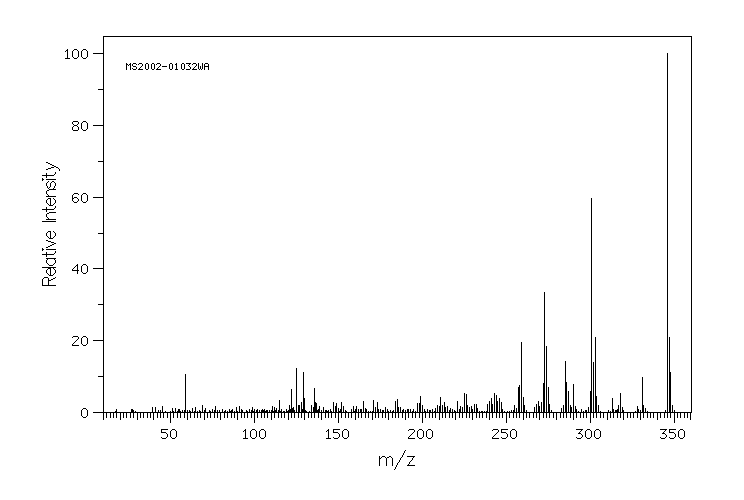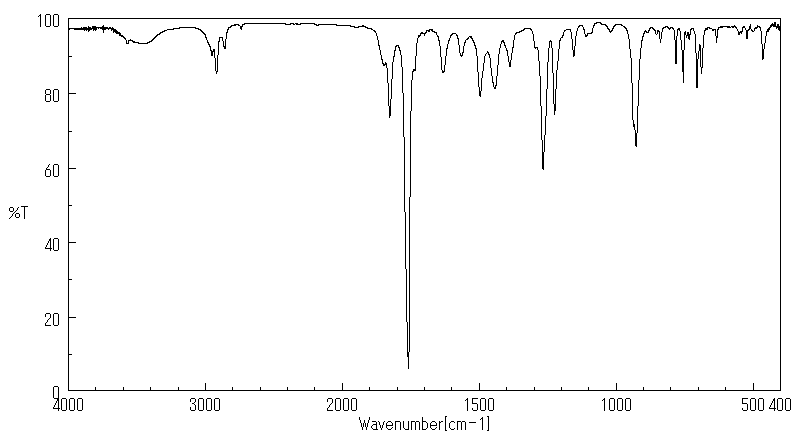2,3-双(2,4,5-三甲基-3-噻吩)马来酸酐 | 112440-47-8
中文名称
2,3-双(2,4,5-三甲基-3-噻吩)马来酸酐
中文别名
2,3-双(2,4,5-三甲基-3-噻吩基)马来酸酐;2,3-双(2,4,5-三甲基-3-噻吩基)马来酐;2-氨基-4-苯基噻吩-3-甲酸甲酯;2,3-二(2,4,5-三甲基-3-噻吩)马来酸酐
英文名称
1,2-bis(2,4,5-trimethylthiophene-3-yl)maleic anhydride
英文别名
1,2-bis(2,4,5-trimethyl-3-thienyl)maleic anhydride;2,3-bis(2,3,5-trimethyl-3-thienyl)maleic anhydride;2,3-bis(2,4,5-trimethyl-3-thienyl)maleic anhydride;2,3-bis(2,3,5-trimethylthienyl)maleic anhydride;3,4-bis(2,4,5-trimethylthiophen-3-yl)furan-2,5-dione
CAS
112440-47-8
化学式
C18H18O3S2
mdl
——
分子量
346.471
InChiKey
ANYDHJQJXVIYHM-UHFFFAOYSA-N
BEILSTEIN
——
EINECS
——
-
物化性质
-
计算性质
-
ADMET
-
安全信息
-
SDS
-
制备方法与用途
-
上下游信息
-
文献信息
-
表征谱图
-
同类化合物
-
相关功能分类
-
相关结构分类
物化性质
-
熔点:168 °C
计算性质
-
辛醇/水分配系数(LogP):4.8
-
重原子数:23
-
可旋转键数:2
-
环数:3.0
-
sp3杂化的碳原子比例:0.33
-
拓扑面积:99.8
-
氢给体数:0
-
氢受体数:5
安全信息
-
海关编码:2934999090
-
储存条件:存放于室温且保存在惰性气体中
SDS
Section I.Chemical Product and Company Identification
Chemical Name 2,3-Bis(2,4,5-trimethyl-3-thienyl)maleic Anhydride
Portland OR
Synonym Not available.
Chemical Formula C18H18O3S2
CAS Number 112440-47-8
Section II. Composition and Information on Ingredients
Chemical Name CAS Number Percent (%) TLV/PEL Toxicology Data
2,3-Bis(2,4,5-trimethyl-3-thienyl)maleic Anhydride 112440-47-8 Min. 95.0 (T) Not available. Not available.
Section III. Hazards Identification
Acute Health Effects No specific information is available in our data base regarding the toxic effects of this material for humans. However,
exposure to any chemical should be kept to a minimum. Skin and eye contact may result in irritation. May be harmful if
inhaled or ingested. Always follow safe industrial hygiene practices and wear proper protective equipment when handling
this compound.
CARCINOGENIC EFFECTS : Not available.
Chronic Health Effects
MUTAGENIC EFFECTS : Not available.
TERATOGENIC EFFECTS : Not available.
DEVELOPMENTAL TOXICITY: Not available.
There is no known effect from chronic exposure to this product. Repeated or prolonged exposure to this compound is
not known to aggravate existing medical conditions.
Section IV. First Aid Measures
Eye Contact Check for and remove any contact lenses. DO NOT use an eye ointment. Flush eyes with running water for a minimum
of 15 minutes, occasionally lifting the upper and lower eyelids. Seek medical attention. Treat symptomatically and
supportively.
Skin Contact If the chemical gets spilled on a clothed portion of the body, remove the contaminated clothes as quickly as possible,
protecting your own hands and body. Place the victim under a deluge shower. If the chemical touches the victim's
exposed skin, such as the hands: Gently and thoroughly wash the contaminated skin with running water and non-abrasive
soap. Be particularly careful to clean folds, crevices, creases and groin. Cover the irritated skin with an emollient. Seek
medical attention. Treat symptomatically and supportively. Wash any contaminated clothing before reusing.
Inhalation If the victim is not breathing, perform artificial respiration. Loosen tight clothing such as a collar, tie, belt or waistband. If
breathing is difficult, oxygen can be administered. Seek medical attention. Treat symptomatically and supportively.
Ingestion INDUCE VOMITING by sticking finger in throat. Lower the head so that the vomit will not reenter the mouth and throat.
Loosen tight clothing such as a collar, tie, belt, or waistband. If the victim is not breathing, administer artificial respiration.
Examine the lips and mouth to ascertain whether the tissues are damaged, a possible indication that the toxic material
was ingested; the absence of such signs, however, is not conclusive. Seek immediate medical attention and, if possible,
show the chemical label. Treat symptomatically and supportively.
Section V. Fire and Explosion Data
Not available.
Combustible. Auto-Ignition
Flammability
Flammable Limits
Flash Points Not available.
Not available.
Combustion Products These products are toxic carbon oxides (CO, CO 2), sulfur oxides (SO2, SO3...).
Fire Hazards
No specific information is available regarding the flammability of this compound in the presence of various materials.
Explosion Hazards Risks of explosion of the product in presence of mechanical impact: Not available.
Risks of explosion of the product in presence of static discharge: Not available.
No additional information is available regarding the risks of explosion.
Fire Fighting Media
SMALL FIRE: Use DRY chemicals, CO 2, water spray or foam.
LARGE FIRE: Use water spray, fog or foam. DO NOT use water jet.
and Instructions
Continued on Next Page
2,3-Bis(2,4,5-trimethyl-3-thienyl)maleic Anhydride
Section VI. Accidental Release Measures
Spill Cleanup In case of a spill and/or a leak, always shut off any sources of ignition, ventilate the area, and exercise caution. Use a
Instructions shovel to put the material into a convenient waste disposal container. Finish cleaning the spill by rinsing any
contaminated surfaces with copious amounts of water. Consult federal, state, and/or local authorities for assistance on
disposal.
Section VII. Handling and Storage
Handling and Storage Keep away from heat and sources of ignition. Mechanical exhaust required. When not in use, tightly seal the container
and store in a dry, cool place. Avoid excessive heat and light. DO NOT breathe dust. In case of insufficient ventilation,
Information
wear suitable respiratory equipment. If you feel unwell, seek medical attention and show the label when possible. Treat
symptomatically and supportively. Avoid contact with skin and eyes.
Always store away from incompatible compounds such as oxidizing agents.
Section VIII. Exposure Controls/Personal Protection
Engineering Controls Use process enclosures, local exhaust ventilation, or other engineering controls to keep airborne levels below
recommended exposure limits. If user operations generate dust, fume or mist, use ventilation to keep exposure to
airborne contaminants below the exposure limit.
Personal Protection Splash goggles. Lab coat. Dust respirator. Boots. Gloves. A MSHA/NIOSH approved respirator must be used to avoid
inhalation of the product. Suggested protective clothing might not be sufficient; consult a specialist BEFORE handling
this product.
Exposure Limits Not available.
Section IX. Physical and Chemical Properties
Physical state @ 20°C Powder. Solubility
Not available.
Not available.
Specific Gravity
Molecular Weight 346.47 Partition Coefficient
Not available.
Boiling Point Not available. Vapor Pressure Not available.
Melting Point 168°C (334.4°F) Vapor Density Not available.
Not available. Not available.
Refractive Index Volatility
Critical Temperature Not available. Odor Not available.
Viscosity Not available. Taste Not available.
Section X. Stability and Reactivity Data
Stability
This material is stable if stored under proper conditions. (See Section VII for instructions)
Conditions of Instability
Avoid excessive heat and light.
Incompatibilities
Reactive with oxidizing agents.
Section XI. Toxicological Information
RTECS Number Not available.
Routes of Exposure Eye contact. Inhalation. Ingestion.
Not available.
Toxicity Data
CARCINOGENIC EFFECTS : Not available.
Chronic Toxic Effects
MUTAGENIC EFFECTS : Not available.
TERATOGENIC EFFECTS : Not available.
DEVELOPMENTAL TOXICITY: Not available.
There is no known effect from chronic exposure to this product. Repeated or prolonged exposure to this compound is not
known to aggravate existing medical conditions.
Acute Toxic Effects No specific information is available in our data base regarding the toxic effects of this material for humans. However,
exposure to any chemical should be kept to a minimum. Skin and eye contact may result in irritation. May be harmful if
inhaled or ingested. Always follow safe industrial hygiene practices and wear proper protective equipment when handling
this compound.
Continued on Next Page
2,3-Bis(2,4,5-trimethyl-3-thienyl)maleic Anhydride
Section XII. Ecological Information
Ecotoxicity Not available.
Environmental Fate Not available.
Section XIII. Disposal Considerations
Recycle to process, if possible. Consult your local or regional authorities. You may be able to dissolve or mix material with
Waste Disposal
a combustible solvent and burn in a chemical incinerator equipped with an afterburner and scrubber system. Observe all
federal, state, and local regulations when disposing of this substance.
Section XIV. Transport Information
DOT Classification Not a DOT controlled material (United States).
PIN Number Not applicable.
Proper Shipping Name
Not applicable.
Packing Group (PG) Not applicable.
DOT Pictograms
Section XV. Other Regulatory Information and Pictograms
TSCA Chemical Inventory This product is NOT on the EPA Toxic Substances Control Act (TSCA) inventory. The following notices are required by 40
CFR 720.36 (C) for those products not on the inventory list:
(EPA)
(i) These products are supplied solely for use in research and development by or under the supervision of a technically
qualified individual as defined in 40 CFR 720.0 et sec.
(ii) The health risks of these products have not been fully determined. Any information that is or becomes available will be
supplied on an MSDS sheet.
WHMIS Classification Not controlled under WHMIS (Canada).
(Canada)
EINECS Number (EEC) Not available.
EEC Risk Statements Not available.
SECTION 16 - ADDITIONAL INFORMATION
N/A
上下游信息
-
上游原料
中文名称 英文名称 CAS号 化学式 分子量 1,2-双(2,4,5-三甲基-3-噻吩基)-反-1,2-二氰基乙烯 trans-1,2-dicyano-1,2-bis(2,4,5-trimethyl-3-thienyl)ethene 112440-50-3 C18H18N2S2 326.486 -
下游产品
中文名称 英文名称 CAS号 化学式 分子量 —— N-phenyl-2,3-bis(2,4,5-trimethyl-3-thienyl)maleimide 1052690-64-8 C24H23NO2S2 421.584 —— N-(3-hydroxyphenyl)-2,3-bis(2,4,5-trimethyl-3-thienyl)maleimide —— C24H23NO3S2 437.584 —— N-(2-hydroxyphenyl)-2,3-bis(2,4,5-trimethyl-3-thienyl)maleimide 155876-10-1 C24H23NO3S2 437.584 —— 1-(9-Ethylcarbazol-3-yl)-3,4-bis(2,4,5-trimethylthiophen-3-yl)pyrrole-2,5-dione 1454710-76-9 C32H30N2O2S2 538.734 —— 7-Amino-11,14,22,26-tetrakis(4-tert-butylphenoxy)-18-[2,5-dioxo-3,4-bis(2,4,5-trimethylthiophen-3-yl)pyrrol-1-yl]-7,18-diazaheptacyclo[14.6.2.22,5.03,12.04,9.013,23.020,24]hexacosa-1(22),2(26),3,5(25),9,11,13,15,20,23-decaene-6,8,17,19-tetrone 1206472-54-9 C82H76N4O10S2 1341.66
反应信息
-
作为反应物:参考文献:名称:皮秒激光光解法研究溶液中1,2-双(2,4,5-三甲基-3-噻吩基)马来酸酐的光致变色反应摘要:皮秒激光光解和瞬态吸收光谱法用于直接观察1,2-双(2,4,5-三甲基-3-噻吩基)马来酸酐的光致变色反应,例如闭环和开环过程在解决方案中。在开环和开环过程中,都发现了非常快速的(<10 ps)反应通道。讨论了超快反应过程的机理及其对溶剂的依赖性。DOI:10.1016/0009-2614(94)01165-6
-
作为产物:描述:3-(氰甲基)-2,4,5-三甲基噻吩 在 氢氧化钾 、 sodium hydroxide 、 苄基三乙基氯化铵 作用下, 以 四氯化碳 为溶剂, 反应 25.5h, 生成 2,3-双(2,4,5-三甲基-3-噻吩)马来酸酐参考文献:名称:Thermally irreversible photochromic systems. Reversible photocyclization of diarylethene derivatives摘要:DOI:10.1021/jo00239a022
文献信息
-
Chemical control of the photochromic reactivity of diarylethene derivatives作者:Masato Ohsumi、Tuyoshi Fukaminato、Masahiro IrieDOI:10.1039/b506801k日期:——Photochemically inactive diarylethene derivatives having a N-(O-hydroxyphenyl) group underwent photochromic reaction when they were esterified by the addition of acetic anhydride.
-
Reversible Fluorescence Photoswitch based on Dye-Crosslinked Dendritic Nanoclusters for High-Contrast Imaging of Living Biological Systems申请人:Kim Yoonkyung公开号:US20120220734A1公开(公告)日:2012-08-30The present invention relates to a reversible fluorescence photoswitch based on the dye-crosslinked dendritic nanoclusters for high-contrast imaging of living biological systems. The dendritic nanocluster according to the present invention consists of two or more dendrimers crosslinked each other to have a globular shape overall, and thereby enhancing the fluorescence intensity and improving the detection sensitivity of the monomeric dendrimers. In addition, the dendritic nanocluster according to the present invention was found to internalize into a living zebrafish by both skin permeation and microinjection, independently. Further, the dendritic nanocluster according to the present invention showed low toxicity and thus it could be useful for both in vivo and in vitro imaging as well as the ex vivo cell tracking applications.
-
Solvent Viscosity Effects on Photochromic Reactions of a Diarylethene Derivative As Revealed by Picosecond Laser Spectroscopy作者:Hiroshi Miyasaka、Takahiro Nobuto、Masataka Murakami、Akira Itaya、Naoto Tamai、Masahiro IrieDOI:10.1021/jp0206626日期:2002.9.1The solvent viscosity effect on photochromic reaction processes such as cyclization and cycloreversion of a diarylethene derivative, 2-bis(2,4,5-trimethyl-3-thienyl)maleic anhydride (TMTMA), was investigated by means of steady-state spectroscopy, picosecond transient absorption, and fluorescence measurements. The cyclization reaction yields from the excited open-ring isomer decreased with an increase
-
Resonance photoionization of a diarylethene derivative in the presence of cyclodextrins using multi-color multi-laser irradiation作者:Tatsuya Takeshita、Michihiro HaraDOI:10.1016/j.jphotochem.2015.05.026日期:2015.9actuators and optical memory. However, the photodynamics of photochromic materials under excitation by three lasers at three different wavelengths are poorly understood. In this article, we investigate the properties of the well-known photochromic material 2,3-bis(2,4,5-trimethyl-3-thienyl) maleic anhydride (1) upon excitation by one, two and three lasers. In these experiments, α-, β- and γ-cyclodextrin (CD)光致变色是光诱导的分子的异构化,对于致动器和光学存储器等应用具有吸引力。然而,人们对在三个不同波长的三个激光激发下光致变色材料的光动力学知之甚少。在本文中,我们研究了众所周知的光致变色材料2,3-双(2,4,5-三甲基-3-噻吩基)马来酸酐(1)在被一台,两台和三台激光激发后的性能。在这些实验中,将α-,β-和γ-环糊精(CD)添加到1中以形成包合物,以改善1在水/乙腈中的溶解度。首先,通过改变1 H NMR谱图评估1 / CD包合物的形成。1和计算。我们发现暴露于溶剂的1 / CD包合物中1的每个分子的面积取决于CD的空腔尺寸,并且CD也影响开放形式(OP)的反平行和平行构象的比率)的1。然后通过一台激光(266 nm),两台激光(266和532 nm)和三台激光(266、532和355 nm)的快速光解在720 nm处观察到在1 / CD系统中水合电子的瞬态吸收。的电离量子产率1既取决
-
Photocyclization reaction of a diarylmaleimide derivative in polar solvents作者:Masato Ohsumi、Masaki Hazama、Tuyoshi Fukaminato、Masahiro IrieDOI:10.1039/b802780c日期:——Photochromism of a symmetric diarylmaleimide derivative, having two thiophene rings (1), and a non-symmetric derivative having a S,S-dioxide thiophene ring and a thiophene ring (2) as the aryl moieties, was studied in various solvents. The photocyclization quantum yield of gradually decreased with increasing the solvent polarity and the reaction was not observed in polar solvents, such as ethanol and
表征谱图
-
氢谱1HNMR
-
质谱MS
-
碳谱13CNMR
-
红外IR
-
拉曼Raman
-
峰位数据
-
峰位匹配
-
表征信息
同类化合物
(2R)-4-十六烷酰基-3-羟基-2-(羟甲基)-2H-呋喃-5-酮
马来酸酐-丙烯酸共聚物钠盐
马来酸酐-d2
马来酸酐-13C4
马来酸酐-1-13C
马来酸酐
顺丁烯酸酐-2,3-13C2
顺丁烯二酐与2,2-二甲基-1,3-丙二醇和1,2-丙二醇的聚合物
雄甾-3,5,9(11)-三烯-17-酮,3-甲氧基-(8CI,9CI)
阿西弗兰
阻垢分散剂
钾抗坏血酸盐
重氮基烯,二环[2.2.1]庚-1-基(1,1-二甲基乙基)-,(Z)-(9CI)
赤藻糖酸钠
螺甲螨酯代谢物 M01
葫芦巴内酯
葡糖型抗坏血酸
苯基顺酐
聚氧乙烯(2-甲基-2-丙烯基)甲基二醚-马来酸酐共聚物
聚乙烯马来酸酐共聚物
聚(甲基乙烯基醚-ALT-马来酸酐)
聚(异丁烯-马来酸酐)
聚(乙烯-co-丙烯酸乙酯-co-顺丁烯二酐)
聚(乙烯-co-丙烯酸丁酯-co-马来酸酐)
维生素C钠
维生素C磷酸酯钠
维生素C磷酸酯
维生素C杂质
维生素C亚铁盐
维生素C乙基醚
维生素 C 磷酸酯镁
维生素 C
维他命C磷酸镁盐
维他命C杂质
纯绿青霉酸
粘氯酸酐
粘氯酸酐
粘氯酸酐
粘康酸内酯
粉青霉酸酐
穿心莲丁素
硫酰胺,(3-氰基-5,6,7,8-四氢-4H-环庚三烯并[b]噻吩并-2-基)-(9CI)
白头翁素
甲基[(2S,3R)-2-乙氧基-3,6-二氢-2H-吡喃-3-基]乙酸酯
甲基7-氧杂双环[2.2.1]庚-2,5-二烯-2-羧酸酯
甲基5-甲基-4,5-二氢-3-呋喃羧酸酯
甲基4-氰基-2,5-二氢-3-呋喃羧酸酯
甲基4-氧代四氢-2-呋喃羧酸酯
甲基4,5-二氢-2-呋喃羧酸酯
甲基3-甲基-2,3-二氢-3-呋喃羧酸酯








